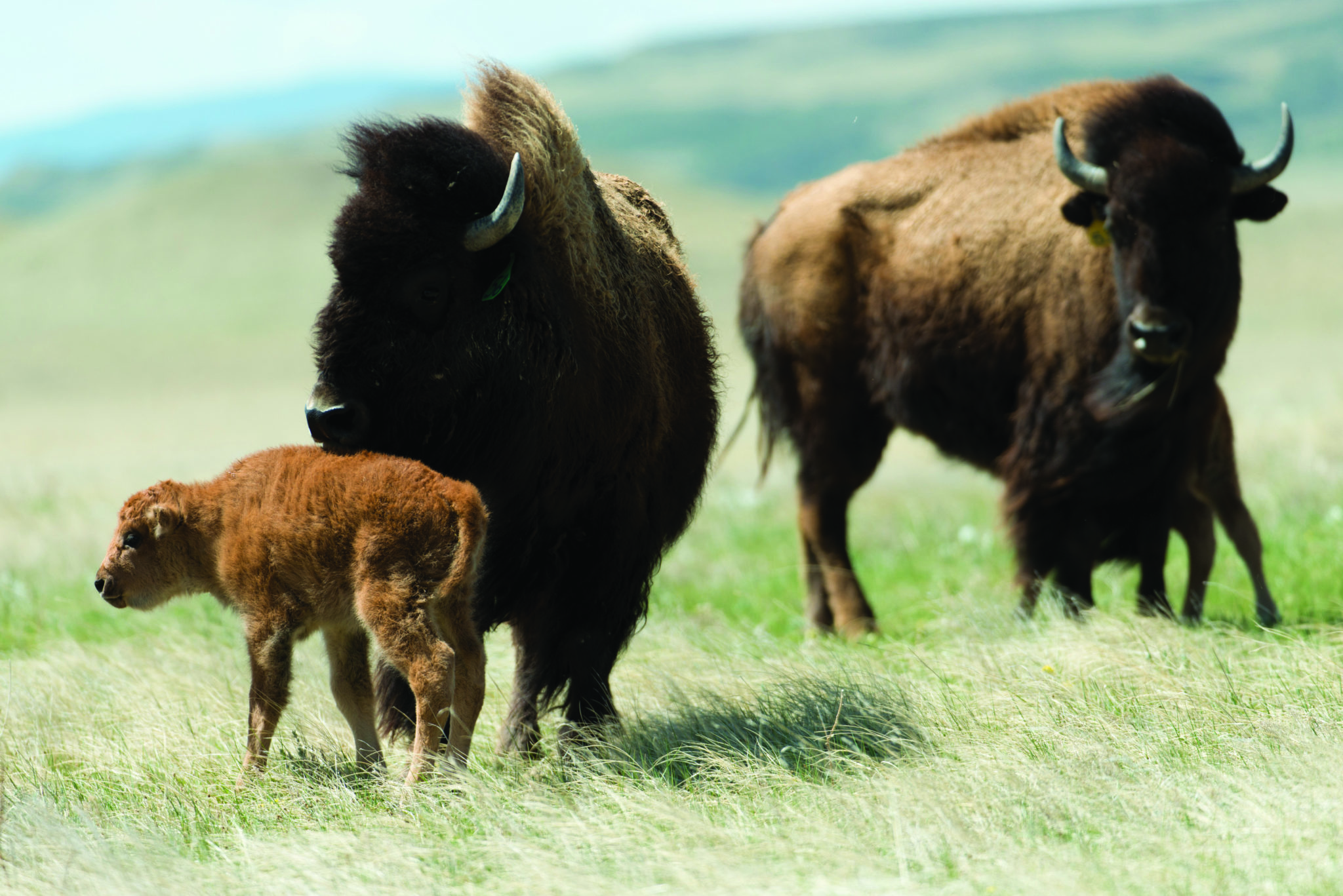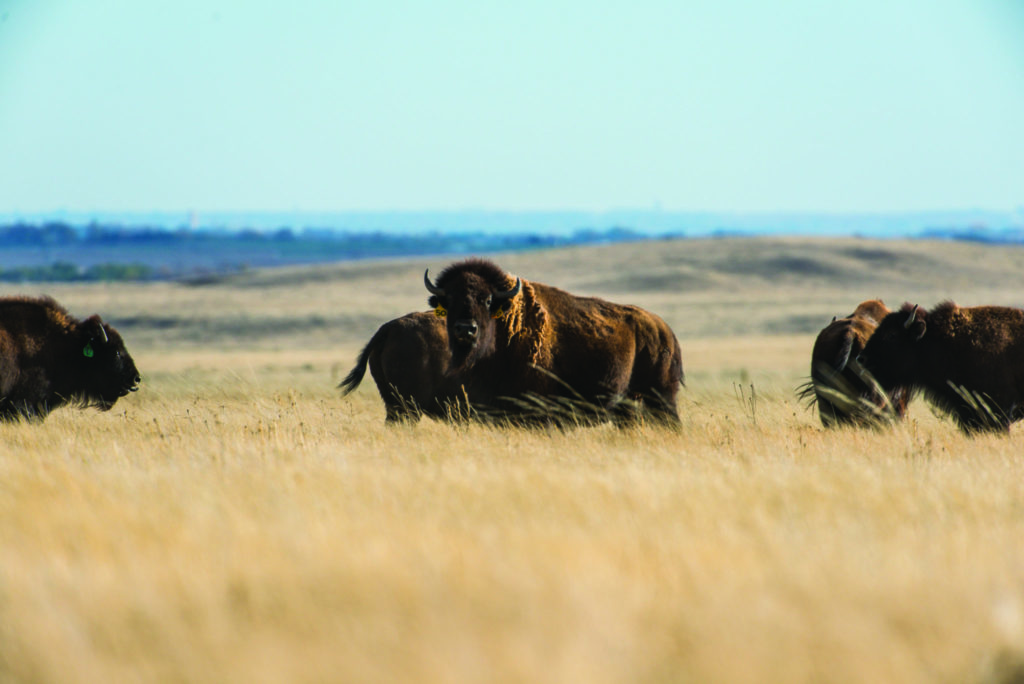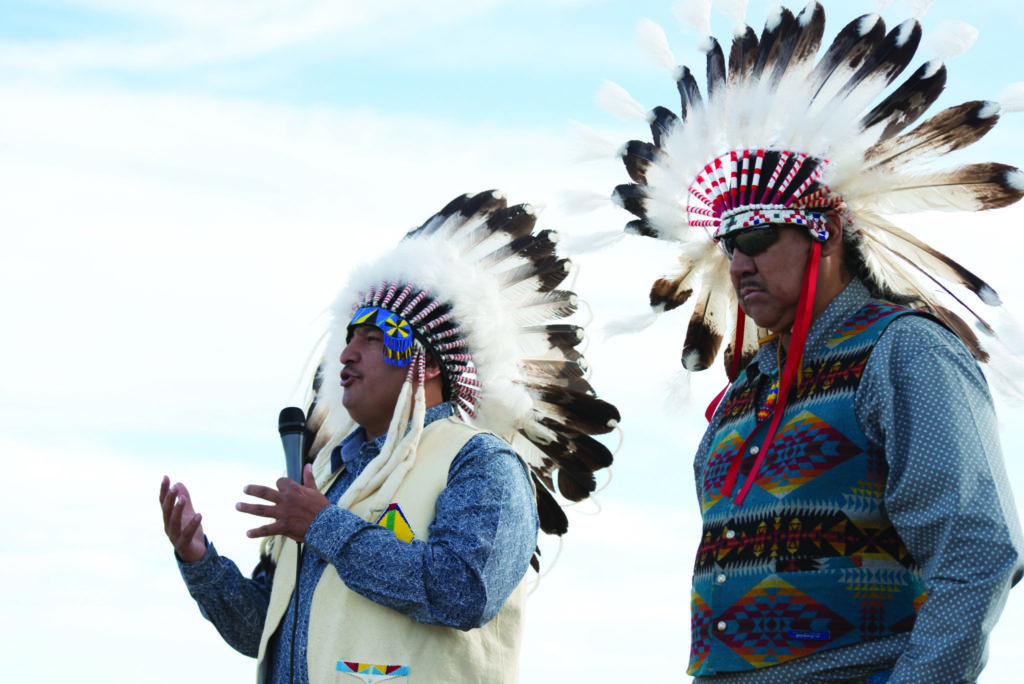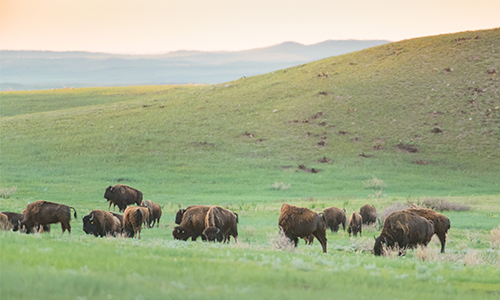By Jennifer J. Folsom
Photos by John Eisele
Rumor has it, he was a skinny bull with tufts of mane and a wild demeanor. As he skittered out of the trailer to join his new herd, he didn’t seem like much. That was 2016. Today, he moves confidently across the dirt road that winds its way through the 4,224-acre Rio Mora National Wildlife Refuge. He strikes an iconic profile as he waits for the rest of the herd to graze toward him. The young calves are proof he belongs.
From generation to generation
Bison being bison on the landscape is a stark contrast to the archival photos of their ancestors’ skulls and wasted bodies piled on the prairie. Bison historically ranged from Alaska to Florida, until the U.S. Army sought to control Native Americans by attempting to exterminate the bison during the 19th century. That long absence of bison in the Southwest is felt strongly by many Indigenous communities.
“It has changed who we are and how we are today,” says Gabriel Montoya Sr., director of special projects for the Pueblo of Pojoaque. Bison is central to the Pojoaque, who worked for years to restore this keystone species to the region with a herd housed at the former private ranch Rio Mora in northern New Mexico. Montoya says bison sustain the pueblo as a community and that partnerships are key. And thanks to a complex network of partnerships among tribes, wildlife conservationists, meat producers, and federal agencies, bison once more belong in the high desert after more than a century of absence.

But the future of the bison isn’t guaranteed. U.S. policies on Native Americans and the land have often prevented or hindered trust in the past, pitting non-Native landowners against Native people, and indigenous species such as wolves, bears, and bison. These tensions set up a conflict between regarding bison as wildlife – free to roam large tracts of land – and bison as livestock in limited ranges. There are now more than 360,000 bison in the U.S., and their value as food and other commodities is well-established. However, according to the U.S. Department of Interior, only 11% of those bison are part of ecological or conservation efforts.
For the Pojoaque and other tribes, restoring the bison takes building trust and strong relationships, despite these conflicts. Their desire to provide traditional foods for their people and restore the richness of their homelands is balanced with their understanding of collaborations outside the pueblo. Communicating their knowledge of bison raises ethical issues about what can be shared as public information and what knowledge needs to stay within the pueblo. Montoya says the Pojoaque’s understanding of the landscape and the bison has been carefully passed from generation to generation. Their priority is preserving that knowledge and their relationship with the bison for the future.
Foothills conservation herd overcomes hurdles
When the Pojoaque hosted the American Bison Society Conference in late 2019, the collaborators at the conference included Jennifer Barfield, professor of biomedical sciences at Colorado State University and the scientific lead for the Laramie Foothills Bison Conservation Herd. The herd provided some of Pojoaque’s initial stock and works with federal agencies, nongovernmental organizations, and tribes to address three major issues facing bison conservation: the need for brucellosis-free stock; the importance of genetic diversity for the future of the species; and habitats large enough to accommodate bison as wildlife.
“Our animals’ ancestors are from Yellowstone, so we want our herd to serve as a seed herd for those who want bison with Yellowstone genetics,” Barfield says. “Many people want brucellosis-free Yellowstone bison, and that’s where our work comes in.”
The need for brucellosis-free stock has been a major hurdle for Plains bison. Brucellosis is an infectious disease that causes spontaneous abortions in cattle. Elk and bison can carry the disease, and elk have passed it to cattle. Brucellosis is endemic only in the greater Yellowstone Area, but any bison that are moved across state borders have to be tested for brucellosis. There has never been a documented case of bison infecting domestic cattle, but making good neighbors with ranchers requires disease-free, genetically pure bison. Barfield applied artificial reproduction technology to achieve just that, so the bulls and cows can relocate anywhere in the United States that can provide a healthy habitat for them.
The herd, now in its fifth year, is a testament to the power of partnerships. The city of Fort Collins Natural Areas Department, Larimer County Natural Resources Department, USDA Animal and Plant Health Inspection Service, and CSU all contributed resources toward the health of the now 77 bison running on the short-grass ecosystem of Soapstone Prairie Natural Area and Red Mountain Open Space in Northern Colorado. The herd has provided female bison to the Heartland Ranch Nature Preserve, part of the Southern Plains Land Trust, in southern Colorado, and bulls for the Pojoaque, the Minnesota Zoo, and Oakland Zoo, where bulls breed and act as ambassadors for the species before heading to other conservation herds. The partners continue to see the herd grow, but they need good working relationships with local landowners and ranchers to realize that goal.
“It is important to become a partner with ranchers who have a relationship to that land,” Barfield says. “We want to be able to manage bison as wildlife and work with the values of those ranching communities nearby.”
Although the tensions between ranchers and conservationists still exist in some areas of the continent, Barfield believes a common love for the land and a commitment to balancing interests holds promise for the goals this network of collaborators is working toward.
A keystone species in action
John Sanderson, director of CSU’s Center for Collaborative Conservation, says the Medano-Zapata herd in the San Luis Valley near the Great Sand Dunes in Colorado presents both opportunities and challenges for the ranch owner, The Nature Conservancy, and the adjacent public lands.
Like most regions in the historical bison range, Colorado still has missing pieces in the ecosystem. Wolves and grizzly bears – both extirpated from Colorado – do not provide vital culling of herds. Managing bison can be expensive because landscapes are limited and their size and power requires larger fences. To allow the Medano-Zapata herd to behave as naturally as possible, all internal fences were removed, creating a single 33,000-acre pasture. Altogether, the Medano-Zapata Ranch includes 100,000 acres and about 2,000 bison.
“The large landscape allowed us to see them as a natural herd and lets them behave like a natural herd,” Sanderson says.
A notable social feature of natural herds is their matriarchal structure, according to the observations of generations of tribal communities. The 8- to 10-year-old females keep the knowledge of where and how to cross flooded streams, for instance. But management that maximizes meat production does not allow for bison to live that long, Sanderson adds.
To address this issue, The Nature Conservancy partnered with a for-profit management company to conduct an annual harvest at Medano-Zapata, selecting for age and gender to maintain the 50/50 ratio seen in natural herds like Yellowstone. The partnership has developed guidelines that prioritize herd health, consider the carrying capacity of the land, and mimic predator habits. This strategy balances the need to use bison as a resource with the benefits of letting the bison manage the land on their own terms.
“Bison managed as wildlife live longer and provide a whole different value to the land, to other species, and to humans,” Sanderson says.
Traditional knowledge and current experience demonstrate that bison are a keystone species with a critical role in ecosystem health. They know how to manage the land and continue to do so once they are reintroduced to the landscape. Bison wallows and dung piles are host to unique microsystems – from Mexico and Alaska, to the Atlantic seaboard and into Florida – renewing precious topsoil in areas that have experienced devastating effects of erosion and overuse. They also carry seeds in their fur and microbes in their dung to renew the land wherever they are. This helps restore plant species, such as shortgrasses, and in turn, the needed diversity of animals and plants that rely on those grasses.
Nature Conservancy conservation ecologist Chris Pague likes to show off the peeled ponderosa pines at the Medano-Zapata, which indicate the bison’s long presence in the high desert landscape and the way they interact with other species. Pague believes TNC’s conservation plan has been a success so far because they have respected the idea that, “Bison should decide what bison do.”
‘Keeping a way of life alive’

Jason Baldes says the importance of the bison goes deeper than its keystone species status. Baldes is a member of the Eastern Shoshone Tribe and the bison coordinator for the National Wildlife Federation Tribal Partnerships Program on the Wind River Reservation in Wyoming. For his people, their past and future relationship is family. The traditional name for the Wind River Shoshone translates to “buffalo eaters,” and bison are a central part of ceremony, health, environmental stewardship, and inspiration for the future.
Many tribes have millennia-old knowledge of the land and the bison, whether they followed them on their migrations north and south or relied on bison for trade goods. These knowledge bases offer a unique way to view bison. The Eastern Shoshone Tribe recently signed the Buffalo Treaty, the largest collaboration addressing continent-wide bison management with 33 signatories from more than 30 tribal nations.
Indigenous leadership and participation will benefit tribes, ranchers, and conservationists alike. CSU Indigenous researcher Doreen Martinez says researchers and conservationists need to seek knowledge and experience from many different sources and prioritize the values, needs and aspirations of the communities the bison will impact.
“It’s a land issue as much as it is a buffalo issue,” Martinez says. As a Native scholar, she has learned from working with Native communities that they connect their close ties to the long-term health of ecosystems with their history with bison. Thus, bison play an essential role in complex ideas of well-being and sustainability.
That idea is in action when the Pueblo of Pojoaque hosts their annual buffalo dance in December. The community celebrates the importance of the bison to bring strength, a healthy ecosystem, and knowing “how to sustain ourselves through whatever we’ve been through,” Montoya says. Their traditions recognize that no one person possesses all of the knowledge about the bison. “When we collaborate as a community, as a whole, each person carries a part of keeping a way of life alive,” Montoya says.
That includes the bison, the land, and the people.
Jennifer J. Folsom has devoted her professional life to education, public health, and journalism, particularly working with individuals and organizations in Indigenous communities. She is a citizen of the Choctaw Nation of Oklahoma and a doctoral candidate and instructor in the Department of Journalism and Media Communication at CSU.







